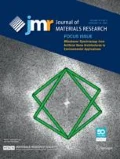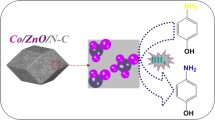Abstract
The development of highly efficient and stable inexpensive catalysts for the reduction of 4-nitrophenol (4-NP) to 4-aminophenol (4-AP) by NaBH4 in an aqueous solution by utilizing metal-organic frameworks (MOFs) as precursor and template remains a hot topic. Herein, a simple self-template strategy was developed to synthesize a porous nitrogen-doped carbon frameworks embedded with zinc and cobalt nanoparticles (Zn0.3Co2.7@NC) catalyst by thermal annealing of the bimetallic zinc-cobalt zeolitic imidazolate framework (Zn0.3Co2.7-ZIF) as an effective precursor and template. The resulting Zn0.3Co2.7@NC catalysts show an excellent catalytic activity for the reduction of 4-NP and the reduction reaction was completed only in 5 min with nearly 100% conversion. The apparent rate constant for the reaction of 4-NP reduction was estimated to be 0.683 min−1. Moreover, the catalyst was extended to reduce other nitro compounds and exhibited excellent catalytic activity. When compared to other related catalysts in the literature, the catalytic activity of catalyst is superior. Therefore, the resulting Zn0.3Co2.7@NC is expected to get more extensive application in the field of catalysis.







Similar content being viewed by others
References
M. Raula, M.H. Rashid, S. Lai, M. Roy, and T.K. Mandal: Solvent-adoptable polymer Ni/NiCo alloy nanochains: Highly active and versatile catalysts for various organic reactions in both aqueous and nonaqueous media. ACS Appl. Mater. Interfaces 4, 878 (2012).
H.M. Torres Galvis, J.H. Bitter, C.B. Khare, M. Ruitenbeek, A.I. Dugulan, and K.P. de Jong: Supported iron nanoparticles as catalysts for sustainable production of lower olefins. Science 335, 835 (2012).
V. van Speybroeck, R. Gani, and R.J. Meier: The calculation of thermodynamic properties of molecules. Chem. Soc. Rev. 39, 1764 (2010).
Y. Lin, Y. Qiao, Y. Wang, Y. Yan, and J. Huang: Self-assembled laminated nanoribbon-directed synthesis of noble metallic nanoparticle-decorated silica nanotubes and their catalytic applications. J. Mater. Chem. 22, 18314 (2012).
N. Yan, Z. Zhao, Y. Li, F. Wang, H. Zhong, and Q. Chen: Synthesis of novel two-phase Co@SiO2 nanorattles with high catalytic activity. Inorg. Chem. 53, 9073 (2014).
M. Zhao, K. Deng, L. He, Y. Liu, G. Li, H. Zhao, and Z. Tang: Core–shell palladium nanoparticle@metal-organic frameworks as multifunctional catalysts for cascade reactions. J. Am. Chem. Soc. 136, 1738 (2014).
A.H. Chughtai, N. Ahmad, H.A. Younus, A. Laypkov, and F. Verpoort: Metal-organic frameworks: Versatile heterogeneous catalysts for efficient catalytic organic transformations. Chem. Soc. Rev. 44, 6804 (2015).
N. Stock and S. Biswas: Synthesis of metal-organic frameworks (MOFs): Routes to various MOF topologies, morphologies, and composites. Chem. Rev. 112, 933 (2012).
A. Aijaz, N. Fujiwara, and Q. Xu: From metal-organic framework to nitrogen-decorated nanoporous carbons: High CO2 uptake and efficient catalytic oxygen reduction. J. Am. Chem. Soc. 136, 6790 (2014).
W. Bak, H.S. Kim, H. Chun, and W.C. Yoo: Facile synthesis of metal/metal oxide nanoparticles inside a nanoporous carbon matrix (M/MO@C) through the morphology-preserved transformation of metal-organic framework. Chem. Commun. 51, 7238 (2015).
Y-Z. Chen, C. Wang, Z-Y. Wu, Y. Xiong, Q. Xu, S-H. Yu, and H-L. Jiang: From bimetallic metal-organic framework to porous carbon: High surface area and multicomponent active dopants for excellent electrocatalysis. Adv. Mater. 27, 5010 (2015).
C. Bai, X. Yao, and Y. Li: Easy access to amides through aldehydic C–H bond functionalization catalyzed by heterogeneous Co-based catalysts. ACS Catal. 5, 884 (2015).
M. Kim, D-H. Nam, H-Y. Park, C. Kwon, K. Eom, S. Yoo, J. Jang, H-J. Kim, E. Cho, and H. Kwon: Cobalt-carbon nanofibers as an efficient support-free catalyst for oxygen reduction reaction with a systematic study of active site formation. J. Mater. Chem. A 3, 14284 (2015).
W. Zhong, H. Liu, C. Bai, S. Liao, and Y. Li: Base-free oxidation of alcohols to esters at room temperature and atmospheric conditions using nanoscale Co-based catalysts. ACS Catal. 5, 1850 (2015).
S. Bai, X. Shen, G. Zhu, M. Li, H. Xi and K. Chen: In situ growth of Ni(x)Co(100-x) nanoparticles on reduced graphene oxide nanosheets and their magnetic and catalytic properties. Appl. Mater. and Interfaces 4, 2378–2386 (2012).
L. Hu, R. Zhang, L. Wei, F. Zhang, and Q. Chen: Synthesis of FeCo nanocrystals encapsulated in nitrogen-doped graphene layers for use as highly efficient catalysts for reduction reactions. Nanoscale 7, 450–454 (2014).
P. Su, H. Xiao, J. Zhao, Y. Yao, Z. Shao, C. Li, and Q. Yang: Nitrogen-doped carbon nanotubes derived from Zn–Fe–ZIF nanospheres and their application as efficient oxygen reduction electrocatalysts with in situ generated iron species. Chem. Sci. 4, 2941 (2013).
L.M. Aguirre-Díaz, F. Gándara, M. Iglesias, N. Snejko, E. Gutiérrez-puebla, and M.Á. Monge: Tunable catalytic activity of solid solution metal-organic frameworks in one-pot multicomponent reactions. J. Am. Chem. Soc. 137, 6132 (2015).
Y-L. Hou, R.W-Y. Sun, X-P. Zhou, J-H. Wang, and D. Li: A copper(i)/copper(ii)-salen coordination polymer as a bimetallic catalyst for three-component Strecker reactions and degradation of organic dyes. Chem. Commun. 50, 2295 (2014).
J. Long, K. Shen, L. Chen, and Y. Li: Multimetal-MOF-derived transition metal alloy NPs embedded in an N-doped carbon matrix: Highly active catalysts for hydrogenation reactions. J. Mater. Chem. A 4, 10254 (2016).
S. Naeem, A. Ribes, A.J.P. White, M.N. Haque, K.B. Holt, and J.D.E.T. Wilton-Ely: Multimetallic complexes and functionalized nanoparticles based on oxygen- and nitrogen-donor combinations. Inorg. Chem. 52, 4700 (2013).
Y. Liao, D. Zhang, Q. Wang, T. Wen, L. Jia, Z. Zhong, F. Bai, L. Tang, W. Que, and H. Zhang: Open-top TiO2 nanotube arrays with enhanced photovoltaic and photochemical performances via a micromechanical cleavage approach. J. Mater. Chem. A 3, 14279 (2015).
Z-Q. Shi, L-X. Jiao, J. Sun, Z-B. Chen, Y-Z. Chen, X-H. Zhu, J-H. Zhou, X-C. Zhou, X-Z. Li, and R. Li: Cobalt nanoparticles in hollow mesoporous spheres as a highly efficient and rapid magnetically separable catalyst for selective epoxidation of styrene with molecular oxygen. RSC Adv. 4, 47 (2014).
Y. Liu, B. Liu, Y. Liu, Q. Wang, W. Hu, P. Jing, L. Liu, S. Yu, and J. Zhang: Improvement of catalytic performance of preferential oxidation of CO in H2-rich gases on three-dimensionally ordered macro- and meso-porous Pt–Au/CeO2 catalysts. Appl. Catal., B 142–143, 615 (2013).
F. Rong, J. Zhao, P. Su, Y. Yao, M. Li, Q. Yang, and C. Li: Zinc-cobalt oxides as efficient water oxidation catalysts: The promotion effect of ZnO. J. Mater. Chem. A 3, 4010–4017 (2015).
Z-F. Huang, J. Song, K. Li, M. Tahir, Y-T. Wang, L. Pan, L. Wang, X. Zhang, and J-J. Zou: Hollow cobalt-based bimetallic sulfide polyhedra for efficient all-pH-value electrochemical and photocatalytic hydrogen evolution. J. Am. Chem. Soc. 138, 1359 (2016).
X. Li, C. Zeng, J. Jiang, and L. Ai: Magnetic cobalt nanoparticles embedded in hierarchically porous nitrogen-doped carbon frameworks for highly efficient and well-recyclable catalysis. J. Mater. Chem. A 4, 7476–7482 (2016).
M. Rakap and S. Özkar: Intrazeolite cobalt(0) nanoclusters as low-cost and reusable catalyst for hydrogen generation from the hydrolysis of sodium borohydride. Appl. Catal., B 91, 21 (2009).
M. Rakap and S. Özkar: Hydroxyapatite-supported cobalt(0) nanoclusters as efficient and cost-effective catalyst for hydrogen generation from the hydrolysis of both sodium borohydride and ammonia-borane. Catal. Today 183, 17 (2012).
X. Li, X. Gao, L. Ai, and J. Jiang: Mechanistic insight into the interaction and adsorption of Cr(VI) with zeolitic imidazolate framework-67 microcrystals from aqueous solution. Chem. Eng. J. 274, 238–246 (2015).
R. Wu, X. Qian, K. Zhou, J. Wei, J. Lou, and P.M. Ajayan: Porous spinel ZnxCo3− xO4 hollow polyhedra templated for high-rate lithium-ion batteries. ACS Nano 8, 6297 (2014).
S. Peng, L. Li, H. Tan, R. Cai, W. Shi, C. Li, S.G. Mhaisalkar, M. Srinivasan, S. Ramakrishna, and Q. Yan: MS2 (M = Co and Ni) hollow spheres with tunable interiors for high-performance supercapacitors and photovoltaics. Adv. Funct. Mater. 24, 2155 (2014).
Y. Xiao, S. Liu, F. Li, A. Zhang, J. Zhao, S. Fang, and D. Jia: 3D hierarchical Co3O4 twin-spheres with an urchin-like structure: Large-scale synthesis, multistep-splitting growth, and electrochemical pseudocapacitors. Adv. Funct. Mater. 22, 4052 (2012).
A. Kong, C. Mao, Q. Lin, X. Wei, X. Bu, and P. Feng: From cage-in-cage MOF to N-doped and Co-nanoparticle-embedded carbon for oxygen reduction reaction. Dalton Trans. 44, 6748 (2015).
J. Wei, Y. Hu, Z. Wu, Y. Liang, S. Leong, B. Kong, X. Zhang, D. Zhao, G.P. Simon, and H. Wang: A graphene-directed assembly route to hierarchically porous Co–Nx/C catalysts for high-performance oxygen reduction. J. Mater. Chem. A 3, 16867 (2015).
Z. Zhang, J. Hao, W. Yang, and J. Tang: Defect-rich CoP/nitrogen-doped carbon composites derived from a metal-organic framework: High-performance electrocatalysts for the hydrogen evolution reaction. ChemCatChem 7, 1920 (2015).
Y. Lü, Y. Wang, H. Li, Y. Lin, Z. Jiang, Z. Xie, Q. Kuang, and L. Zheng: Mof-derived porous Co/C nanocomposites with excellent electromagnetic wave absorption properties. ACS Appl. Mater. Interfaces 7, 13604 (2015).
N.L. Torad, M. Hu, S. Ishihara, H. Sukegawa, A.A. Belik, M. Imura, K. Ariga, Y. Sakka, and Y. Yamauchi: Direct synthesis of MOF-derived nanoporous carbon with magnetic Co nanoparticles toward efficient water treatment. Small 10, 2096 (2014).
N. Khemasiri, C. Chananonnawathorn, A. Klamchuen, S. Jessadaluk, A. Pankiew, S. Vuttivong, P. Eiamchai, M. Horprathum, S. Pornthreeraphat, P. Kasamechonchung, K. Tantisantisom, T. Boonkoom, P. Songsiririthigul, H. Nakajima, and J. Nukeaw: Crucial role of reactive pulse-gas on a sputtered Zn3N2 thin film formation. RSC Adv. 6, 94905 (2016).
N. Jiang, D.G. Georgiev, A.H. Jayatissa, R.W. Collins, J. Chen, and E. McCullen: Zinc nitride films prepared by reactive RF magnetron sputtering of zinc in nitrogen containing atmosphere. J. Phys. D: Appl. Phys. 45, 135101 (2012).
X-K. Kong, Z-Y. Sun, M. Chen, C-L. Chen, and Q-W. Chen: Metal-free catalytic reduction of 4-nitrophenol to 4-aminophenol by N-doped graphene. Energy Environ. Sci. 6, 3260 (2013).
Y. Yang, W. Zhang, X. Ma, H. Zhao, and X. Zhang: Facile construction of mesoporous N-Doped carbons as highly efficient 4-nitrophenol reduction catalysts. ChemCatChem 7, 3454 (2015).
L. Ma, X. Shen, G. Zhu, Z. Ji, and H. Zhou: CoP nanoparticles deposited on reduced graphene oxide sheets as an active electrocatalyst for the hydrogen evolution reaction. Carbon 77, 255–265 (2015).
K-L. Wu, X-W. Wei, X-M. Zhou, D-H. Wu, X-W. Liu, Y. Ye, and Q. Wang: NiCo2 alloys: Controllable synthesis, magnetic properties, and catalytic applications in reduction of 4-nitrophenol. J. Phys. Chem. C 115, 16268–16274 (2011).
Y. Yang, Y. Zhang, C.J. Sun, X. Li, W. Zhang, X. Ma, Y. Ren, and X. Zhang: Heterobimetallic metal-organic framework as a precursor to prepare a nickel/nanoporous carbon composite catalyst for 4-nitrophenol reduction. ChemCatChem 6, 3084–3090 (2014).
S. Bai, X. Shen, G. Zhu, M. Li, H. Xi, and K. Chen: In situ growth of NixCo100− x nanoparticles on reduced graphene oxide nanosheets and their magnetic and catalytic properties. ACS Appl. Mater. Interfaces 4, 2378–2386 (2012).
X. Wang, D. Liu, S. Song, and H. Zhang: Heterobimetallic metal-organic framework as a precursor to prepare a nickel/nanoporous carbon composite catalyst for 4-nitrophenol reduction. J. Am. Chem. Soc. 135, 15864–15872 (2013).
J. Li, C.Y. Liu, and Y. Liu: Au/graphene hydrogel: Synthesis, characterization and its use for catalytic reduction of 4-nitrophenol. J. Mater. Chem. 22, 8426–8430 (2012).
L. Ai, H. Yue, and J. Jiang: Environmentally friendly light-driven synthesis of Ag nanoparticles in situ grown on magnetically separable biohydrogels as highly active and recyclable catalysts for 4-nitrophenol reduction. J. Mater. Chem. 22, 23447–23453 (2012).
S.C. Tang, S. Vongehr, and X.K. Meng: Environmentally friendly light-driven synthesis of Ag nanoparticles in situ grown on magnetically separable biohydrogels as highly active and recyclable catalysts for 4-nitrophenol reduction. J. Phys. Chem. C 114, 977–982 (2010).
ACKNOWLEDGMENTS
Financial support from the National Natural Science Foundation of China (Nos. 21162027 and 21261022) is gratefully acknowledged.
Author information
Authors and Affiliations
Corresponding authors
Supplementary Material
Rights and permissions
About this article
Cite this article
Xu, X., Li, H., Xie, H. et al. Zinc cobalt bimetallic nanoparticles embedded in porous nitrogen-doped carbon frameworks for the reduction of nitro compounds. Journal of Materials Research 32, 1777–1786 (2017). https://doi.org/10.1557/jmr.2017.148
Received:
Accepted:
Published:
Issue Date:
DOI: https://doi.org/10.1557/jmr.2017.148




